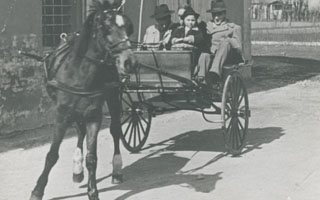The horse, buggy and "farmer’s pride"

Together with oxen, cows and veal calves, many farmers also raised a horse or - better yet, a mare - whom they could periodically breed in order to obtain a colt to raise and sell. Horses were used principally to pull vehicles for human transport and the occasional light load. The farmer families used a cart (bruzén) to deliver their in-kind payments to the landowner (eggs, hens, capons, grapes) as well as carry milk to the dairy.
The cart was also used to transport suckling pigs and veal to market. A buggy with rubber-covered wheels (dumadòura) was instead used to travel to church, town or market and to settle accounts with the landowner. Although tolerated, the practice of tenant farmers keeping horses was viewed with disfavor by the landowners in the mid-1800s. The agronomist Giovanni Contri underlined how horses damaged the interests of the landowners, calling them “a waste of forage and grazing grass for the sole purpose of fanning the farmer’s pride”.